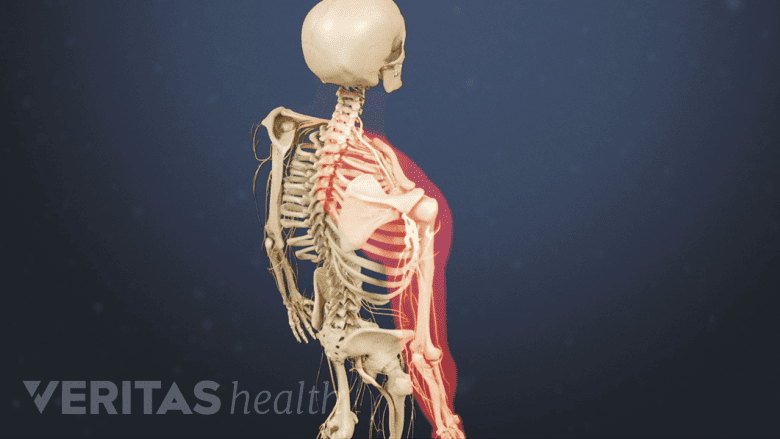Cervical radiculopathy is the clinical description of when a nerve root in the cervical spine becomes inflamed or damaged, resulting in a change in neurological function. Neurological deficits, such as numbness, altered reflexes, or weakness, may radiate anywhere from the neck into the shoulder, arm, hand, or fingers. Pins-and-needles tingling and/or pain, which can range from achy to shock-like or burning, may also radiate down into the arm and/or hand.
In This Article:
Cervical Nerve Roots and Radiculopathy

Cervical radiculopathy is caused by irritation or compression of the cervical nerve roots.
There are 8 pairs of cervical nerve roots, numbered C1 through C8, in the cervical spine. These nerve roots branch from the spinal cord and exit both sides of the spinal canal through an intervertebral foramen (small bony opening between the adjacent vertebrae). These cervical nerves then branch out further to supply muscles that enable functioning of the shoulders, arms, hands, and fingers. They also carry sensory fibers to the skin that provide sensation.
The most common causes of cervical radiculopathy are when a nerve root becomes inflamed or damaged due to a nearby bone spur or cervical herniated disc, such as from spinal degeneration over time or an injury.1Caridi JM, Pumberger M, Hughes AP. Cervical radiculopathy: a review. HSS J. 2011; 7(3): 265–272. Many other less common causes of cervical radiculopathy are possible, such as infection or tumor.
The exact mechanism of nerve irritation or damage is not always understood in cervical radiculopathy. Chemical processes related to inflammation are thought to most commonly cause damage to the nerve root that results in radiculopathy, rather than a true mechanical impingement of the nerve root.
The Course of Cervical Radiculopathy
Cervical radiculopathy is a rare condition that occurs slightly more often in men than women.2Woods BI, Hilibrand AS. Cervical radiculopathy: epidemiology, etiology, diagnosis, and treatment. J Spinal Disord Tech. 2015; 28(5):E251-9. It is more likely to occur in older people due to spinal degeneration, with some estimates putting the highest risk for ages 50 to 54.3Childress MA, Becker BA. Nonoperative management of cervical radiculopathy. Am Fam Physician. 2016; 93(9):746-54. When cervical radiculopathy occurs in younger people, it is more likely due to disc herniation or injury.3Childress MA, Becker BA. Nonoperative management of cervical radiculopathy. Am Fam Physician. 2016; 93(9):746-54.
See Cervical Radiculopathy from a Herniated Cervical Disc
Cervical radiculopathy signs and symptoms most commonly appear intermittently at first—coming and going—but they could also develop suddenly or gradually. Some movements or head positions, such as putting the neck in extension (with the head back), may exacerbate the symptoms in some cases.
Most cases of cervical radiculopathy are self-limiting and go away on their own. There is limited evidence for whether any one nonsurgical treatment is more effective than others.3Childress MA, Becker BA. Nonoperative management of cervical radiculopathy. Am Fam Physician. 2016; 93(9):746-54. In the early stages, most recommendations are to try a combination of one or more treatments, such as rest or activity modification, physical therapy, manual manipulation, ice and/or heat therapy.
When Cervical Radiculopathy Is Serious

Worsening symptoms of cervical radiculopathy may necessitate prompt medical attention.
In rare cases, cervical radiculopathy may continue to progress with numbness and/or weakness getting worse despite treatments. The longer that numbness and/or weakness lasts in the shoulder, arm, or hand, the more likely that these deficits will become permanent or lead to paralysis. When nonsurgical treatments fail to adequately manage the symptoms and nerve compression has been confirmed, surgery may need to be considered in order to decompress the nerve.
- 1 Caridi JM, Pumberger M, Hughes AP. Cervical radiculopathy: a review. HSS J. 2011; 7(3): 265–272.
- 2 Woods BI, Hilibrand AS. Cervical radiculopathy: epidemiology, etiology, diagnosis, and treatment. J Spinal Disord Tech. 2015; 28(5):E251-9.
- 3 Childress MA, Becker BA. Nonoperative management of cervical radiculopathy. Am Fam Physician. 2016; 93(9):746-54.

